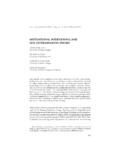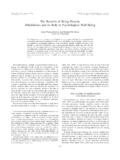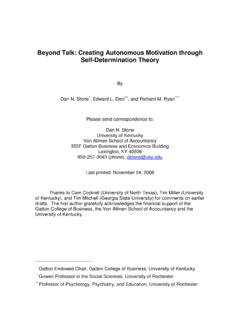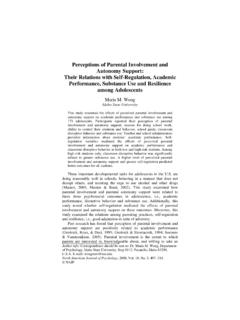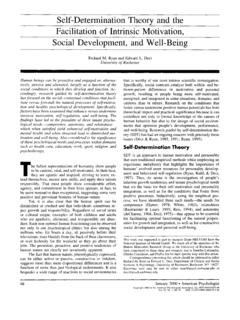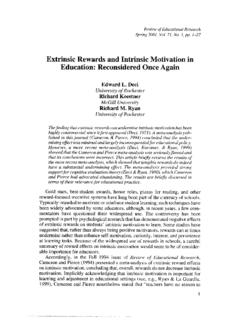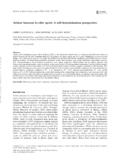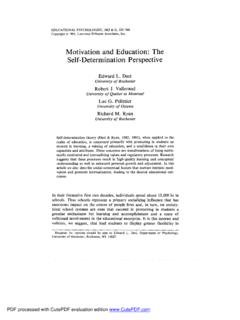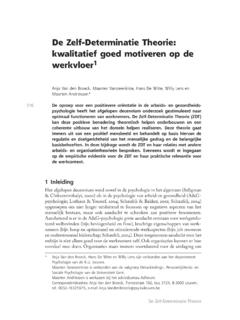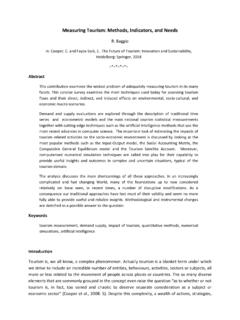Transcription of TARGET ARTICLE The “What” and “Why” of Goal Pursuits ...
1 TARGET ARTICLEThe What and Why of Goal Pursuits :Human needs and the Self-Determination of BehaviorEdward L. Deci and Richard M. RyanDepartment of PsychologyUniversity of RochesterSelf-determination theory (SDT) maintains that an understanding of human motiva-tion requires a consideration of innate psychological needs for competence, auton-omy, and relatedness. We discuss the SDT concept of needs as it relates to previousneed theories, emphasizing that needs specify the necessary conditions for psycholog-ical growth, integrity, and well-being.
2 This concept of needs leads to the hypothesesthat different regulatory processes underlying goal Pursuits are differentially associ-ated with effective functioning and well-being and also that different goal contentshave different relations to the quality of behavior and mental health, specifically be-cause different regulatory processes and different goal contents are associated withdiffering degrees of need satisfaction . Social contexts and individual differences thatsupport satisfaction of the basic needs facilitate natural growth processes includingintrinsically motivated behavior and integration of extrinsic motivations, whereasthose that forestall autonomy, competence, or relatedness are associated with poorermotivation, performance, and well-being.
3 We also discuss the relation of the psycho-logical needs to cultural values, evolutionary processes, and other contemporary mo-tivation contemporary theories of motivation assumethat people initiate and persist at behaviors to the ex-tent that they believe the behaviors will lead to desiredoutcomes or goals. Beginning with the work of Lewin(1936) and Tolman (1932), this premise has led moti-vation researchers to explore the psychological valuepeople ascribe to goals ( , T. Kasser & Ryan, 1996;Vroom, 1964), people s expectations about attaininggoals ( , Abramson, Seligman, & Teasdale, 1978;Bandura, 1989; Rotter, 1966), and the mechanisms thatkeep people moving toward selected goals ( ,Carver & Scheier, 1998).
4 Whereas initially this approach assumed that anytwo equally valued goals with the same expectanciesfor attainment would yield the same quality of perfor-mance and affective experience, recent work ongoal-directed behavior has begun to distinguishamongtypesof goals or outcomes. Researchers have,for example, contrasted ability-development goalswith ability-demonstration goals (Dweck, 1986;Nicholls, 1984) and approach goals with avoidancegoals (Carver & Scheier, 1998; Elliot & Church,1997; Higgins, 1996), suggesting that the differenttypes of goals have different behavioral and these other theories, self-determination theory(SDT.)
5 Deci & Ryan, 1980, 1985b, 1991) has differen-tiated the concept of goal-directed behavior, yet it hastaken a very different approach. SDT differentiates thecontentof goals or outcomes and theregulatory pro-cessesthrough which the outcomes are pursued, mak-ing predictions for different contents and for differentprocesses. Further, it uses the concept ofinnate psy-chological needsas the basis for integrating the differ-entiations of goal contents and regulatory processesand the predictions that resulted from those differentia-tions.
6 Specifically, according to SDT, a critical issue inthe effects of goal pursuit and attainment concerns thedegree to which people are able to satisfy their basicpsychological needs as they pursue and attain their val-ued concept of needs was once widely employed inempirical psychology to organize the study of motiva-tion. Although variously defined at the physiologicalor psychological levels and as innate or learned, theconcept of needs specified thecontentof motivationPsychological InquiryCopyright 2000 by2000, Vol.
7 11, No. 4, 227 268 Lawrence Erlbaum Associates, provided a substantive basis for the energizationand direction of action. Beginning around the 1960s,however, the dramatic shift toward cognitive theoriesled to the concept of needs being repudiated and re-placed by the concept of goals as the dominant motiva-tional concept. The focus became the processes of goalselection and pursuit rather than the content of thegoals being selected and pursued. The concept of va-lence (or psychological value) of outcomes was de-fined functionally (and thus was not related to needsatisfaction), much as the concept of reinforcementhad been defined functionally in operant psychology(B.)
8 F. Skinner, 1953), ignoring the needs that had pro-vided the underpinning of reinforcements in drive the-ories ( , Hull, 1943).Since the time of the shift toward cognitive theories,most motivation theorists remained unwilling to con-sider needs , focusing instead on goal-related has, in contrast, maintained that a full understand-ing not only of goal-directed behavior, but also of psy-chological development and well-being, cannot beachieved without addressing the needs that give goalstheir psychological potence and that influence whichregulatory processes direct people s goal , in SDT.
9 Three psychological needs forcompetence, relatedness, and autonomy are consid-ered essential for understanding thewhat( , content)andwhy( , process) of goal Pursuits . Before outlin-ing the SDT perspective on the content and process ofgoal-directed behavior, however, we begin with an his-torical consideration of the concept of needs as a foun-dation for our subsequent Concept of NeedsEarly needs TheoriesTwo very different intellectual traditions in the em-pirical psychology of motivation employed the con-cept of needs .
10 In experimental psychology, Hull(1943) suggested that the task of psychology is to un-derstand molar behavior by linking it to the organism sprimary needs and the conditions in the environmentrelevant to them. He specified a set of innate physio-logical needs ( , for food, water, sex) that are basedin non-nervous-system tissue deficits, give rise to drivestates, push the organism into action, and must be satis-fied for the organism to remain healthy. The drivestates, when reduced, produce learning by linkingdrive stimulations to the responses that led to drive re-duction ( , Hull, 1943; Spence, 1956).
